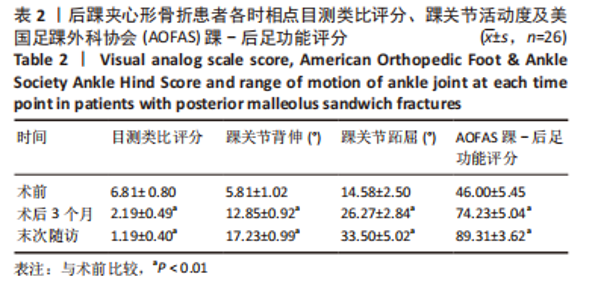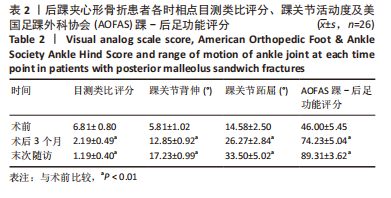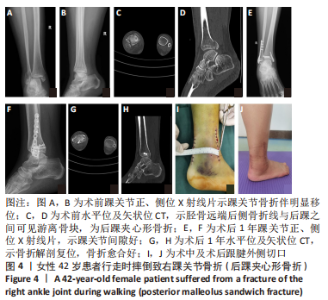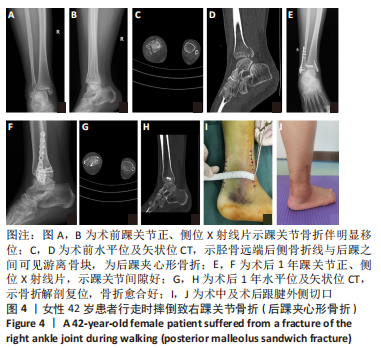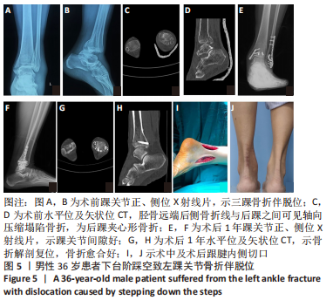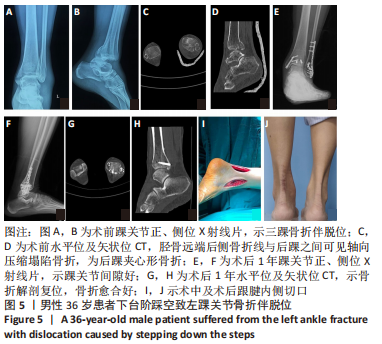[1] TOSUN B, SELEK O, GOK U, et al. Posterior malleolus fractures in trimalleolar ankle fractures: Malleolus versus transyndesmal fixation. Indian J Orthop. 2018;52(3): 309-314.
[2] 王旭, 耿翔, 张超, 等. 后Pilon骨折Die-punch骨块的CT分型及应用[J]. 中华创伤骨科杂志,2018,20(6):470-475.
[3] 王建卫, 黄路, 章相锋, 等. 成人后踝骨折夹层骨块的特征[J]. 中华骨科杂志, 2019,39(5):291-297.
[4] 廖明新, 王岩, 孙宁, 等. 踝关节骨折中后踝骨折的发生率及手术固定的相关因素分析[J]. 中华创伤骨科杂志,2019,21(7):575-580.
[5] 黄杰, 施鸿飞, 熊进, 等. 后踝骨折关节面塌陷X线片与CT图像的准确性研究[J]. 中华创伤杂志,2020,36(4):332-334.
[6] KANG C, HWANG DS, LEE JK, et al. Screw fixation of the posterior malleolus fragment in ankle fracture. Foot Ankle Int. 2019;40(11):1288-1294.
[7] PALMANOVICH E, OHANA N, YAACOBI E, et al. Preoperative planning and surgical technique for optimizing internal fixation of posterior malleolar fractures: CT versus standard radiographs. J Orthop Surg Res. 2020;15(1):119-125.
[8] 马梓元, 郭胜洋, 高峰, 等. 经后外侧入路钢板和螺钉内固定治疗后踝骨折疗效比较[J]. 中国修复重建外科杂志,2021,35(4):431-438.
[9] MCHALE S, WILLIAMS M, BALL T. Retrospective cohort study of operatively treated ankle fractures involving the posterior malleolus. Foot Ankle Surg. 2020;26(2):138-145.
[10] BLOM RP, HAYAT B, AL-DIRINI RMA, et al. Posterior malleolar ankle fractures:predictors of outcome. Bone Joint J. 2020;102-B(9):1229-1241.
[11] 戴坤权, 姚粤峰, 熊奡, 等. 不同大小后踝骨折块的手术选择及疗效分析[J]. 中华骨与关节外科杂志,2020,13(4):304-308.
[12] NEVILE BH, CHARNLEY AD. The treatment of displaced fractures at the ankle by rigid internal fixation and early joint movement. J Bone Joint Surg Br. 1965;47(4):634-660.
[13] KITAOKA HB, ALEXANDER IJ, ADELAAR RS, et al. Clinical rating systems for the ankle-hindfoot, midfoot, hallux, and lesser toes. Foot Ankle Int. 1997;18(3):187-188.
[14] 张宇, 孙海钰, 陈斌. 后外侧入路在后Pilon骨折中的应用[J].实用骨科杂志, 2019,25(5):438-441.
[15] MARTIN KD. Posterior arthroscopic reduction and internal fixation for treatment of posterior malleolus fractures. Foot Ankle Int. 2020;41(1):115-120.
[16] KARIM A, AACFAS ESD, TAYLOR BC, et al. Ankle fracture fixation: medial or lateral first? J Foot Ankle Surg. 2019;58(1):75-79.
[17] 陈宇,张晖,刘熹,等. 经改良后内侧入路联合支撑技术治疗关节面塌陷的后Pilon骨折[J].中华医学杂志,2019,99(21):1631-1635.
[18] JIANG Z, ZHANG C, QIN JJ, et al. Posterior pilon fracture treated by opening the fibula fracture gap. J Orthop Surg Res. 2022;17(1):1-9.
[19] 赖志斌, 朱永展, 邹运璇, 等.改良后内侧经踇长屈肌外侧入路治疗后Pilon骨折[J].中华医学杂志,2021,101(15):1077-1082.
[20] WEBER M. Trimalleolar fractures with impaction of the posterome-dialtibial plafond: implications for talar stability. Foot Ankle Int. 2004;25(10):716-727.
[21] HARAGUCHI N, HARUYAMA H, TOGA H, et al. Pathoanatomy of posterior malleolar fractures of the ankle. J Bone Joint Surg (Am). 2006;88(5):1085-1092.
[22] BARTONICK J, RAMMELT S, KOSTLIVY K, et al. Anatomy and classification of the posterior tibial fragment in ankle fractures. Arch Orthop Trauma Surg. 2015;135(4): 505-516.
[23] VERHAGE SM, BOOT F, SCHIPPER IB, et al. Open reduction and internal fixation of posterior malleolar fractures using the posterolateral approach. Bone Joint J. 2016; 98-B(6):812-817.
[24] 黄路, 王建卫, 高宇, 等.缝合锚钉治疗踝关节骨折合并的下胫腓联合损伤的疗效[J].中华骨科杂志,2021,41(15):1059-1065.
[25] 王栋, 曾德斌, 林乔,等. CT评估踝关节骨折螺钉内固定后的下胫腓联合复位情况[J].中国组织工程研究,2020,24(33):5349-5353.
[26] MARKOLF KL, JACKSON SR, MCALLISTER DR. Syndesmosis xa on using dual 3.5 mm and 4.5 mm screws with tricor cal and quadricor cal purchase: a biomechanical study. Foot Ankle Int. 2013;34(5):734-739.
[27] PEI Z, YUAN L, HE J, et al. A systematic review of suture-button versus syndesmotic screw in the treatment of distal tibiofibular syndesmosis injury. Bmc Musculoskelet Disord. 2017;18(1):286-291.
[28] RAMMELT S, OBRUBA P. An update on the evaluation and treatment of syndesmotic injuries. Eur J Trauma Emerg Surg. 2015;41(6):601-614.
[29] 胡长青, 连勇, 范虓, 等. 胫骨平行定位法置入下胫腓螺钉治疗下胫腓联合分离的踝关节骨折[J]. 中华骨科杂志,2018,38(21):1293-1300.
[30] PANCHBHAVI VK. Deltoid Ligament Injuries Associated with Ankle Fractures-Argument for Repair of the Deltoid Ligament. J Foot Ankle Surg. 2020;7(1):5-7.
[31] HSU AR, LAREAU CR, ANDERSON RB. Repair of acute superficial deltoid complex avulsion during ankle fracture fixation in national football league players. Foot Ankle Int. 2015;36:1272-1278.
[32] YU GR, ZHANG MZ, AIYER A, et al. Repair of the acute deltoid ligament complex rupture associated with ankle fractures: A multicenter clinical study. J Foot Ankle Surg. 2015;54(2):198-202.
[33] WOO SH, BAE SY, CHUNG HJ. Short-term results of a ruptured deltoid ligament repair during an acute ankle fracture fixation. Foot Ankle Int. 2018;39(1):35-45.
[34] 孙旭, 李庭, 孙志坚, 等. 三角韧带加强修补治疗合并三角韧带损伤及下胫腓分离的踝关节骨折[J]. 中华医学杂志,2018,98(39):3192-3196.
[35] SHEN JJ, GAO YB, HUANG JF, et al. Suture anchors for primary deltoid ligament repair associated with acute ankle fractures. Acta Orthop Belg. 2019;85(3):387-391.
[36] 罗刚, 倪卫东, 郭世航,等.缝合锚修复三角韧带深层治疗混合型内侧损伤踝关节骨折疗效观察[J].中国修复重建外科杂志,2020,34(11):1387-1391.
|


